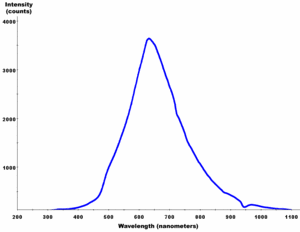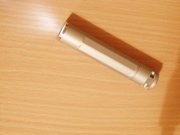Flashlight
 Green flashlight
Green flashlight
A flashlight or torch is a hand-held portable electric spotlight. It is known as a flashlight mainly in the United States and Canada and as a torch in most Commonwealth countries.
A typical flashlight consists of a small electric lightbulb with associated parabolic reflector, powered by electric batteries, and with an electric power switch. The components are mounted in a housing that contains the necessary electric circuit and provides ease of handling, a means of access to the batteries for replacement, and a clear covering over the lightbulb for its protection.
Although a relatively simple device, its invention did not occur until the late 19th century because it depended upon the earlier invention of the electric battery and electric light. The batteries in the first ones were of such short useful life that the common method of operating them was to flash them just long enough to discern the environs, and only as needed; hence the term "flash-light".

Recently, flashlights which use light-emitting diodes (LEDs) instead of conventional lightbulbs have become available. LEDs are far more efficient, and use less power than normal lightbulbs. Such torches have longer battery lifetimes. LEDs also survive sharp blows that often break conventional lightbulbs. Another innovation in flashlight design is the headlamp, a flashlight worn on the head for hands-free operation. Powerful headlamps mounted on helmets have been used in mining for decades, but general-purpose ones with fabric straps are now also available.
Most flashlights are cylindrical in design, with the lamp assembly attached to one end. However, early designs came in a variety of shapes. Many resembled lanterns of the day, consisting largely of a box with a handle and the lamp attached to the front. Some others were made to have a similar appearance to candles. It is possible that future developments of battery and LED technology will bring interesting new designs. For instance, one very small light that exists now in 2004 consists of a few LEDs with a switch, designed to be an endcap for a 9-volt battery.

High-quality flashlights go for as much as several hundreds of dollars. Such flashlights are very advanced, using special batteries, have adjustable brightness levels, dive-depth waterproof ratings, interchangeable optics, and are very bright.
Other power sources
Since batteries are a burdensome cost in advanced countries, let alone in the third world, the development of batteryless torches is a welcome advance. Some use solar panels to recharge their batteries during the day. The clockwork torch has a spring with a winding-up handle, which powers the torch for a period of time.
Windup Flashlight: Winding crank connected to a stepper motor that feeds several bridge rectifiers with their outputs connected in parallel feeding an FET that charges a super capacitor that connects to Super bright LEDs. Crank for 1 minute and get hours of light.
The Everlife Flashlight, has an internal gen in which the whole light is shaken in order to charge a capacitor, then turned on. Other models have hand cranks that generate electricity, and some are combined with radios, for example, the C Crane[1] and the Baygen radio. One of Grundig's radios is self powered and features an incandescent bulb for light. The hand generated torch (UK Design 9986637) has a ratchet operated dynamo. The light produced by this torch is very uneven, rising and falling as the hand squeezes in and out - but some light is better than none. Self powered flashlights are ideal for emergency preparedness.
See also
External links
Hobbyists who enjoy modifying and collecting flashlights enjoy a forum at Candlepower Forums (also known as CPF).
